Common menu bar links
Breadcrumb Trail
ARCHIVED - Department of Justice Canada
 This page has been archived.
This page has been archived.
Archived Content
Information identified as archived on the Web is for reference, research or recordkeeping purposes. It has not been altered or updated after the date of archiving. Web pages that are archived on the Web are not subject to the Government of Canada Web Standards. As per the Communications Policy of the Government of Canada, you can request alternate formats on the "Contact Us" page.
SECTION II – ANALYSIS OF PROGRAM ACTIVITIES BY STRATEGIC OUTCOME
Strategic Outcome I: A fair, relevant and accessible justice system that reflects Canadian values
The Department of Justice works with partners across the federal, provincial and territorial levels of governments and with stakeholders across Canada to develop and maintain a fair, relevant and accessible justice system.
There are three core expected results related to this strategic outcome4:
- The Department continually responds to the evolving legal framework.
- Policies and laws are developed in response to identified needs and gaps and are integrated with Government of Canada priorities and commitments.
- Programs are developed and implemented in response to identified needs and gaps and are integrated with Government of Canada priorities and commitments.
In terms of performance against these three expected results, the Department actively supported the government in responding to identified needs and gaps. By way of example, the Department of Justice accounted for 21 of the 125 bills tabled in Parliament between April 2007 and March 2008. This represented 17 per cent of the government’s full legislative agenda in the House for the period.
In responding to the government’s priorities with regard to the Tackling Crime agenda, the Department dedicated significant human resources to the legislative reform process including ongoing reviews of case law, significant federal-provincial-territorial consultations on reform proposals and extensive work with senior officials from federal and provincial governments to refine proposals.
The Department seeks to attain this strategic outcome through two program activities: Justice policies, laws and programs; and the Office of the Federal Ombudsman for Victims of Crime.
4 Strategic Outcome: A long-term, enduring benefit to Canadians that stems from a department or agency’s mandate, vision and efforts. It represents the difference a department or agency wants to make for Canadians and should be a clear measurable outcome that is within the department or agency’s sphere of influence. (TBS Results Based Management Lexicon — http://www.tbs-sct.gc.ca/rma/lex-lex_e.asp)
Program Activity A1: Justice policies, laws and programs 5
Under Canada’s federal system, the administration of justice is an area of shared jurisdiction between the federal government and the provinces. Through this program activity, the Department fulfills its constitutional responsibility to ensure a bilingual and bijural national legal framework for the administration of justice by developing policies, laws and programs to strengthen the national framework within the following domains: criminal justice (including safety and security, youth criminal justice, support to victims of crime, and international criminal justice); family justice; access to justice; Aboriginal justice; and, private international and public law.
As well, in recognition of the federal government’s shared interest in a sustainable justice system, the Department also provides significant ongoing funding to provinces and territories for the delivery of programs that are in direct support of federal policy objectives, including legal aid, youth justice services and Aboriginal Courtwork program.
Financial Resources (in millions of dollars)
|
Planned Spending
|
Authorities
|
Actual Spending |
|
429.6
|
432.8
|
408.3
|
Human Resources (in full-time equivalents)
|
Planned
|
Actual
|
Difference
|
|
363
|
342
|
-21
|
For fiscal year 2007–08, the Justice policies, laws and programs activity focused on two key priorities: ensuring an effective and accessible justice system and protecting Canadian communities.
5 Program Activity A1 — Justice policies, laws and programs — combines the previous Program Activities A1 (Developing policies and laws) and A2 (Developing and implementing programs). Please see the PAA Crosswalk
on page 11 of this report.
1. Criminal Justice Program
The Criminal Justice Program is central to the Government of Canada’s priority of Tackling Crime and Strengthening the Security of Canadians. The breadth of criminal law issues for which the Department maintains the capacity to support the government in its efforts to tackle crime and strengthen the security of communities is extensive. Over the reporting period (April 1, 2007 to March 31, 2008) the Department has supported the government in developing, introducing and enacting timely legislative reforms related to criminal law, including:
- Restricting conditional sentences.
- Enacting mandatory penalties for firearms offences, reformed the dangerous offender’s regime and imposed a reverse onus at bail for serious firearms offences.
- Increasing the age of consent.
- Enhancing investigative tools including the expansion of DNA sampling of offenders.
- Proposing mandatory penalties for drug offences.
- Proposing new offences to address identity theft.
- Strengthening the law to address impaired driving.
- Strengthening measures to hold youth more accountable for criminal activities.
- Enacting reforms to the Criminal Code to strengthen sentencing measures, improve criminal procedure and clarify court-related language rights provisions.
Criminal law reform is not simply measured by the tabling of legislation for Parliament’s consideration, but as well in the extensive work that goes into the development of reform options and the support for legislative proposals once developed. In this regard, the Program is heavily involved in coordinating and leading consultations with provinces and territories as well as other stakeholders on criminal law reforms; preparing Cabinet briefings and Memoranda to Cabinet; developing detailed background communications materials and briefing books for bills; providing detailed briefings to senior officials, Ministers and staff to support legislative reform proposals; and preparing the Minister and staff throughout all stages of the legislative process in both Chambers of Parliament as well as appearances before House and Senate Committees.
In pursuit of the Department’s ongoing priority to protect Canadian communities, the Criminal Justice Program was actively engaged in four areas: safety and security initiatives, youth criminal justice issues, addressing the concerns of victims of crime and pursuing international criminal justice partnerships.
Safety and Security
The Department has been working with partner departments to modernize Canada’s laws, including the Criminal Code, to address new technologies and support international commitments in the environment of new technologies. This initiative will give police needed and appropriate tools to investigate modern crimes, especially those committed via computer systems, including child pornography, drug trafficking and organized crime. It also supports the government’s commitment to enhance public safety and national security, secure the Canadian border and ensure hemispheric security in the Americas.
The Department is also leading the implementation of the interdepartmental National Anti-Drug Strategy. The Strategy is a collaborative effort involving the Department of Justice, Public Safety Canada and Health Canada. The departments are working together to establish policies and programs that prevent illicit drug use, treat those with illicit drug dependencies, and combat the production and distribution of illicit drugs.
The Department directly supported the Government of Canada’s Tackling Crime agenda during 2007–08 with the development of several bills, of which seven were tabled in the House or Senate (and one of which merged five bills that died on the Order Paper from the previous Session of Parliament). The Department also provided the Government with extensive advice and support in preparing responses to over 60 Private Members Bills and Motions as well as with respect to other legislative and regulatory initiatives.
In addition to the government legislation, the Department supported the participation of the Minister, Deputy Minister and the Senior Associate Deputy Minister at various international fora on criminal justice issues, including the Commonwealth Law Ministers and Senior Officers Meeting; the 10th Canada–United States Cross-Border Crime Forum; the G8 Justice and Home Affairs Ministerial meeting; the Meeting of Ministers of Justice or of Ministers or Attorneys General of the Americas (REMJA), held under the auspices of the Organization of American States; and the Ministerial Forum on Organized Crime.
Results Achieved:
- Developed and supported the passage of Bill C-2 (now S.C. 2008, c.6) (Tackling Violent Crime Act), which reintroduced many proposed reforms that died on the Order Paper at prorogation (September 2007). Bill C-2 enacts mandatory penalties of imprisonment for firearms offences, increases the age of consent, strengthens the law governing dangerous offenders and long-term offenders, imposes a reverse onus for bail for firearms offences, and strengthens the law governing impaired driving (whether by alcohol or drugs).
- Supported the passage of Bill C-9, An Act to amend the Criminal Code (conditional sentence of imprisonment) (now S.C. 2007, c. 12). The amendments, which restrict the availability of conditional sentences, were proclaimed into force on December 1, 2007.
- Reintroduced former Bill C-23, An Act to Amend the Criminal Code (criminal procedure, language of the accused, sentencing and other amendments) as Bill C-13 (now S.C. 2008, c. 18. ) and supported its passage by the House of Commons and Senate.
- Developed Bill C-26, An Act to amend the Controlled Drugs and Substances Act and to make consequential amendments to other Acts.
- Developed Bill C-27, An Act to amend the Criminal Code (Identity theft and related misconduct) which received First Reading in the House of Commons on November 21, 2007.
- Prepared the Annual Reports of the Attorney General of Canada under the Anti-terrorism Act.
- Prepared the Government Response to the House of Commons Subcommittee recommendations on the Anti-terrorism Act, which was tabled in the House of Commons on July 18, 2007.
- Developed Bill S-3, An Act to Amend the Criminal Code (investigative hearing and recognizance with conditions) and supported the development of Bill C-3, An Act to amend the Immigration and Refugee Protection Act (certificate and special advocate) and make a consequential amendment to another Act.
- Completed a summative evaluation of the Department of Justice Public Safety and Anti-terrorism (PSAT) Initiative in June 2007 which concluded that the program was effective. For more information, please see:
http://www.justice.gc.ca/eng/pi/eval/rep-rap/07/psat-spat/sum-som/index.html. - Saw six Justice bills receive Royal Assent: C-26, An Act to amend the Criminal Code (criminal interest rate) received Royal Assent on May 3, 2007 as S.C. 2007, c.9; C-9, An Act to amend the Criminal Code (conditional sentence of imprisonment) received Royal Assent on May 31, 2007 as 2007, c.12; C-48, An Act to amend the Criminal Code in order to implement the United Nations Convention against Corruption, received Royal Assent on May 31, 2007as S.C.2007, c.13; C-18, An Act to amend certain Acts in relation to DNA Identification, received Royal Assent on June 22, 2007, as S.C.2007, c.22; C-59, An Act to amend the Criminal Code (unauthorized recording of a movie), received Royal Assent on June 22, 2007 as S.C.2007, c.28; and C-2, Tackling Violent Crime Act, received Royal Assent on February 28, 2008 as S.C. 2008, c.6.
Youth Justice
The Department of Justice funds activities designed to review policies and laws and develop options for policy, program and legislative reform to achieve a fairer and more effective youth justice system that responds to emerging youth criminal justice issues. During 2007–08, the Department provided discretionary grants and contribution funding to provinces, territories, nongovernmental organizations, Aboriginal organizations and youth justice stakeholders to respond to emerging issues and contribute to achieving a fairer and more effective youth justice system.
Specific areas of focus included pilot projects dealing with bail supervision programs and chronic offenders, and strategies for addressing youth involvement with guns, gangs and drugs. A total of 15 new projects targeting youth in conflict and involved in gun, gang and drug activities were supported through discretionary funds. The majority of the projects funded were for pilot programs responding to youth in conflict with the law and at risk of being involved or already involved in gun, gang and drug activities in order to promote the making of “smart choices” through community-based educational, cultural, sporting and vocational opportunities. These projects included mentoring programs, employment and pro-social skills development programs, after-custody plans and support programs for youth with FASD involved in gangs, Aboriginal mentoring and cultural awareness programs, and a specialized program for female youth who are in conflict with the law and involved in gangs.
Aside from project funding, the Department facilitated the sharing of best practices and raised awareness of emerging justice issues pertaining to youth involved in gangs through a number of roundtables/forums with youth justice stakeholders from across the country.
In addition, the Department continued to provide financial support to the provinces and territories for a range of youth justice services supporting federal youth justice policy objectives. New five-year agreements were also offered to the provinces and territories to assist them in providing the specialized services required for the assessment and treatment of serious violent offenders with mental health issues.
Results Achieved:
- Co-chaired the federal/provincial/territorial (FPT) Pre-trial Detention Working Group. The group met several times in person and held 35 teleconferences.
- Saw Bill C-25 introduced on November 19, 2007, to amend the Youth Criminal Justice Act (YCJA) by adding deterrence and denunciation as sentencing principles and strengthening pre-trial detention provisions for youth who pose a risk to public safety.
- Supported the October 9, 2007, announced comprehensive review of the YCJA and its launch through a February 15, 2008, meeting of FPT Attorneys General.
- Completed negotiations and made a formal offer for the new five-year financial agreements (2008–2013) under the Intensive Rehabilitative Custody and Supervision (IRCS) Program issued February 13, 2008.
- Supported 15 new projects targeting youth involved in gun, gang and drug activities. The value of these projects for 2007–08 was $1,668,130.
- Provided financial support under the Youth Justice Services Funding Program so that provinces and territories could support policies and programs in high priority areas and innovative youth justice approaches.
Victims of Crime
The Department of Justice coordinates an overall federal Victims of Crime Initiative including all relevant federal legislation and programs within the Justice Canada mandate. The Department works with the provinces and territories to develop policy and projects aimed at enhancing the role of the victim in the criminal justice system and achieving a better balance between the rights of victims and offenders.
In 2007–08 the Department continued to work with the Federal Provincial Territorial Working Group on Victims of Crime, the Victim Advisory Committee and other partners to identify and respond to existing and emerging victim issues. Through this work the Department has been able to implement strategies to measure the effect of changes to the Criminal Code and Canada Evidence Act to facilitate the testimony of young and other vulnerable witnesses as well as the effectiveness of other victim-related Criminal Code provisions such as restitution, victim impact statements and victim surcharge. As such, the Department implemented two new programs in 2007–08 to improve the experience of victims of crime:
- Northern Program to increase the capacity of victim service providers in the three territories. Under this program salary dollars were provided for four new Crown Witness Coordinators (CWCs) and a CWC training event was delivered.
- Victims of Crime Abroad Program provides training to consular officers and offices about victim issues, funding and support available through the Victims Fund. In 2007–08, four training sessions were delivered by the Policy Centre for Victim Issues (PCVI) to Foreign Affairs consular staff on new funding for Canadians victimized abroad.
The Department, through contributions managed under the Victims Fund, also provides assistance to the provinces and territories to assist in implementing victim-related Criminal Code provisions. In 2007–08 significant enhancements to the Victims Fund were implemented, increasing the Fund from approximately $2 million per year to $7.75 million per year. The new resources were used for several purposes:
- to provide financial assistance to Canadians victimized abroad;
- to expand support for registered victims to have a support person attend National Parole Board hearings with them;
- to increase support for victims in northern community justice committees; and
- to increase resources for provincial and territorial government partners to increase services to victims.
Results Achieved:
- Chaired and led the work with the FPT WG on Victims of Crime and other partners to identify and respond to existing and emerging victim issues.
- Continued to implement the existing and ongoing mandate of the Federal Victims Strategywhich includes law reform and policy development, and assistance to provinces with the implementation of amendments to the Criminal Code and development of tools to measure the effect of such amendments.
- Planned and sponsored the second annual NVCAW in April 2007 which included a one-day symposium to launch the week.
- Developed models for and supported the establishment of the Office of the Federal Ombudsman for Victims of Crime, established effective relationships with the Federal Ombudsman for Victims of Crime, and coordinated responses to the Ombudsman’s inquiries and recommendations.
- Provided financial support to 410 victims and 75 support persons to attend National Parole Board hearings (totalling $323,974). More registered victims attended NPB hearings in 2007–08 (461) than in 2006–07 (409).
- Provided funding for grants ($254,394) and contribution agreements ($2,590,935) to a wide base of stakeholders. The projects and activities funded in 2007–08 included training events, program evaluation, research and networking.
- Provided $733,989 to provincial and territorial governments to implement legislation to benefit victims and to advance the Canadian Statement of Basic Principles of Justice for Victims of Crime.
- Completed the mid-term evaluation, which found that the Victims of Crime Initiative is on track to meet program objectives.
- Surveyed Victims Fund recipients to assess impact. Victims of crime who received funding reported reduced financial hardship and an increased willingness to participate in and an overall improved experience with the criminal justice process.
International Criminal Justice
Globalization and developments in technologies have led to a rapid increase in transnational crime that threatens the security of Canadians. Domestic means alone cannot effectively deal with these transnational criminal activities. The need for a coordinated international response has required the Department of Justice to advance Canadian interests in the development of global anti-crime and terrorism measures, and to assist other countries with domestic crime problems that can affect regional security and stability and the safety of Canadians at home and abroad.
The participation of Justice officials in intergovernmental bodies over the past year has expanded the capacity and knowledge base for criminal law policy development in Canada, articulated Canadian knowledge and values internationally, and served Canada’s global interests in preventing and suppressing crime, while promoting the rule of law, human rights and sustainable development principles.
Results Achieved:
- Participated at the International Civil Aviation Organization in the ongoing development of two draft protocols to amend the Convention for the Suppression of Unlawful Seizure of Aircraft and the Convention for the Suppression of Unlawful Acts against the Safety of Civil Aviation and was involved in the ongoing negotiation of a bilateral agreement with the United States concerning integrated cross-border maritime law enforcement.
- Participated in the development and delivery of a report to the United Nations Commission on Crime Prevention and Criminal Justice on the subject of transnational economic fraud and identity-related crime.
- Participated in the 17th session of the United Nations Commission on Crime Prevention and Criminal Justice, which adopted two resolutions introduced by Canada on “Fraud and identity-related crime” and on “Information-gathering instrument in relation to UN standards and norms in crime prevention and criminal justice.”
- Supported Bill C-48 (An Act to amend the Criminal Code in order to implement the United Nations Convention against Corruption), which received Royal Assent on May 31, 2007.
- Participated in the Global Initiative to Fight Human Trafficking, a UN initiative to coordinate the global fight on human trafficking on the basis of the United Nations Protocol to Prevent, Suppress and Punish Trafficking in Persons especially Women and Children.
- Led or participated in the ongoing work of mechanisms that have been created to follow up on the implementation of the Inter-American Convention against Corruption, the Convention on Combating Bribery of Foreign Public Officials in International Business Transactions (OECD Convention), the United Nations Convention against Transnational Organized Crime (UNTOC), and its relevant protocols, the United Nations Convention Against Corruption (UNCAC), and has been involved in the work of the Financial Action Task Force (FATF) with respect to money laundering and terrorist financing, as well as with efforts to prepare the terms of reference for a review mechanism for the UNCAC.
- Participated in the Group of Experts, which was established to develop a sample format for the voluntary provision of supplementary information in respect of the UNTOC and the UNCAC and to explore all possibilities of using modern information technology to facilitate such reporting.
- Delivered technical assistance through the Organization of American States (OAS) on cyber crime in the spring of 2008.
- Funded and assisted in the organization and delivery of training to the OAS / Ministers of Justice or Attorneys General of the Americas (REMJA) Working Group on Mutual Legal Assistance and Extradition in March 2008.
- Participated in the Criminal and Legal Affairs Experts Sub-Group of the G8 Roma/Lyon Anti-Crime and Terrorism Groups, including playing a leadership role promoting work to address identity theft.
- Participated in several Ministerial meetings that promoted international cooperation in the fight against transnational organized crime and terrorism, including the Canada-US Cross Border Crime Forum (Quebec City) and the 2007 Meeting of G8 Ministers of Justice and the Interior (Germany).
2. Family Justice Program
Family law is an area of shared constitutional jurisdiction. The Constitution Act, 1867, gives Parliament the power over “marriage and divorce” in s. 91(26) while the provincial legislatures are given the power over “the solemnization of marriage in the province” in s. 92(12), “property and civil rights” in s. 92(13) and the “administration of justice in the province” in s. 92(14).
The Family Justice Program is responsible for legal and strategic policy advice and litigation support services with respect to the Divorce Act, the Civil Marriage Act and with respect to the two pieces of federal support enforcement legislation: the Family Orders and Agreements Enforcement Assistance Act (FOAEAA) and the Garnishment, Attachment and Pension Diversion Act (GAPDA). The Program is also responsible for a component of the Family Violence Initiative and coordinates policy work and research related to provisions in the Criminal Code.
To carry out its mandate, the Program conducts policy analysis and provides advice to senior management and the Minister on most legal issues related to families and children. The Program acts as a centre for family law and family violence expertise to all government departments, provinces and territories. In litigated cases relating to family law it provides advice and precedents to litigators, thus reducing time spent on preparing pleadings. It also provides advice in cases with a family law component, such as immigration or income tax matters.
The Program administers the Family Law Assistance Services (FLAS) to support the Divorce Act, FOAEAA and GAPDA. The Department operates the Central Registry of Divorce Proceedings (CRDP), a national registry service that contains all applications for divorce in Canada since 1968. The Registry exists to prevent duplicate divorce proceedings and is used to resolve possible jurisdictional disputes that may arise under the Divorce Act. Following verification of jurisdiction, the Department issues a clearance certificate to the appropriate family court to allow the divorce application to proceed.
The Department also delivers direct federal support enforcement services to the provincial and territorial maintenance enforcement programs (MEPs) and acts as a “gateway” for the MEPs to access other federal departments. Under GAPDA, the Department garnishes federal employee wages and/or pensions when they are in default, in collaboration with Public Works and Government Services Canada (PWGSC), among other federal departments.
Under FOAEAA, the Department searches federal information databanks to locate support debtors and child abductors, intercepts federal funds and denies federal licences, including passports. These services are essential to those who are owed support and to provincial and territorial MEPs responsible for the enforcement of support obligations.
Key activities during 2007–08 included the preparation and adoption of amendments to federal family law regulations, including: an amendment to the Federal Child Support Guidelines with updated child support tables; another in response to the new government benefit — the Universal Child Care Benefit (UCCB); and an amendment to the Family Support Orders and Agreements Garnishment Regulations to add the Apprenticeship Incentive Grant as a garnishable federal fund that might otherwise be paid to individuals who are in default of their family support obligations.
The Minister of Justice entered into a Memorandum of Agreement under section 25.1 of the Divorce Act with the province of Newfoundland and Labrador. Agreements were made the previous year with Manitoba and Prince Edward Island. With these agreements, the provincial recalculation services will be in a position to recalculate child support amounts ordered under the Divorce Act. As a result, children of divorced parents in these provinces will be able to benefit from recalculation, as do children whose parents have separated or never married.
The Department also updated, in collaboration with the provinces and territories, an “Inventory of Government-based Family Justice Services” that is posted on the departmental Internet site (http://canada.justice.gc.ca/eng/pi/pad-rpad/res/fjis-rsgjf/brows-fure.asp). The Inventory is a user-friendly tool that is accessible to all Canadians with the objective of enabling an individual in any province or territory to obtain information concerning the government-based family justice services in his or her jurisdiction and elsewhere in Canada.
The Department’s Child Support (http://canada.justice.gc.ca/en/ps/sup/) and Parenting After Divorce (http://canada.justice.gc.ca/en/ps/pad/) websites provide useful and highly sought-after information for Canadian families. During 2007–08 there were 181,441 downloads of research reports on topics of child support, custody, access and enforcement of support and 1,188,588 downloads of public legal education materials such as the Step-by-Step Guide to the Federal Guidelines, the provincial or territorial Federal Child Support Tables and Divorce Law: Questions and Answers. As well, during the reporting period, the Department released the following research reports: Resources for Youth Undergoing the Separation or Divorce of their Parents (R. Birnbaum), and Listening to Youths about their Needs and Preferences for Information Relating to Parental Separation and/or Divorce and Research on Resources for Children and Youths Undergoing Parental Separation and Divorce: A Literature Review (R. Birnbaum).
Along with child support activities, the Department developed policy and program options in relation to family justice and elder abuse; drafted the government response to the Senate report on children and tabled it in the House of Commons; and led a Canadian delegation that contributed to the successful negotiation of the new Hague Convention on the International Recovery of Child Support and Other Forms of Family Maintenance.
The Department also provided input to international discussions on women’s and children’s rights, particularly in the context of family violence including the UNGA 62 resolutions and the UN High-level segment on Children (A World Fit for Children Follow-up) and provided input to the government response to the UN Study on Violence Against Children.
Legislative initiatives on this front included support for the government in the consideration of Senate Bill S-209, An Act to amend the Criminal Code (protection of children), as well as drafting the family law and family violence portions of the INAC-led Bill C-47, An Act respecting family homes situated on First Nation reserves and matrimonial interests or rights in or to structures and lands situated on those reserves.
Results Achieved:
- Signed 15 Child-centred Family Justice Fund contribution agreements to support and promote the continuing development of provincial and territorial family justice services.
- Completed field audits of Prince Edward Island, Quebec and Ontario agreements. The audits found that provinces were implementing the agreements appropriately.
- Provided funding for three pilot projects, eight public legal education and information (PLEI) organizations and professional training projects, and five projects under Article 41 of the Official Languages Act.
- Prepared a “Supporting Families through Separation and Divorce” strategy.
- Published “What Happens Next? Information for Kids about Separation and Divorce.”
- Disseminated, through the Family Children and Youth section (FCY), 35,375 copies of the children’s booklet: What Happens Next?; 15,392 copies of Divorce Law: Questions and Answers; 47,627 copies of Step by Step; 55,800 Child Support Tables; 5000 Calendars for Children; and 2000 Informational Postcards.
- Received approximately 10,000 calls to the FCY Information Line in 2007–08.
- Facilitated 1,900,168 website downloads of research reports and PLEI materials from FCY’s websites.
- Garnished and distributed $121,698,141 on behalf of provinces and territories, to Canadian families to satisfy child and spousal support obligations in 2007–08, an increase of almost $2 million from the previous year.
- Received and processed 10,794 applications for suspension or denial of passports and federal licences held by debtors in persistent support arrears. In addition, DOJ received and processed 25,858 tracing applications from provinces and territories seeking to find support debtors, which represents an increase of more than 1,000 applications from the previous year.
3. Access to Justice Program
Access to justice initiatives represent an important structural support to an efficient and effective justice system, and as such underpin public confidence in the justice system. Many of the specific program sub-activities under the broad umbrella of Access to Justice Programs unfold within areas of shared jurisdiction for the administration of justice with the provinces and territories, reflecting our shared interests in the overall sustainability of the Canadian justice system.
Many of the areas within the Canadian judicial system require the federal government to play a significant, influential, if not direct fundamental role. For example, a series of constitutional, quasi-constitutional and legislative provisions govern the use of English and French within the justice system in Canada. At the federal level, this legal framework is circumscribed by section 133 of the Constitution Act, 1867, subsection 19(1) of the Canadian Charter of Rights and Freedoms, the Official Languages Act and the linguistic provisions of the Criminal Code, s. 530 and 530.1, which allow an accused to be tried in the official language of his or her choice.
As well, under Part VII, Section 41 of the Official Languages Act the federal government is committed to promoting linguistic duality by enhancing the vitality of official language minority communities and by promoting the use of both official languages in Canadian society.
Legal Aid
The provision of criminal legal aid is integral to the effective and appropriate functioning of Canada’s criminal justice system. For more than 35 years, the Department of Justice has provided funding in support of criminal legal aid service delivery by the provinces and criminal and civil legal aid by the territories through contribution agreements. Legal aid funding for the territories is provided through Access to Justice Services Agreements that also integrate funding Aboriginal Courtwork and public legal education and information services. By providing these resources, over the reporting period, the federal government:
- maintained its policy role in ensuring that the justice system is efficient, fair, relevant and accessible;
- supported the provision of legal aid services to economically disadvantaged Canadians who are facing serious criminal charges pursuant to the Criminal Code, the Extradition Act or the Fugitive Persons Act;
- supported the provision of legal aid services to young people involved in proceedings relating to the Youth Criminal Justice Act; and
- supported the provision of legal aid services to immigrants and refugees.
During 2007–08, the Terms and Conditions for the Legal Aid Program were renewed for the period 2007–08 to 2011–12 and an Accountability, Risk and Audit Framework (ARAF) was prepared for the current five-year period of the Program’s Terms and Conditions. The ARAF will support the Program’s efforts to strengthen accountability for achieving objectives; improve program performance through results-focused management; actively monitor and manage the risks of the Program; and develop and use information for decision making.
Results Achieved:
- Signed 10 legal aid agreements (provincial) for the two-year period 2007–2009.
- Signed 38 Court-Ordered Council in Federal Prosecution agreements and 7 Public Security and Anti-terrorism (PSAT) legal aid agreements.
- Played the lead role in coordinating the FPT Permanent Working Group on Legal Aid as well as Legal Aid sub-committees.
- Assisted the Permanent Working Group on Legal Aid in holding seven meetings and five teleconferences on legal aid issues and helped create a Criminal Legal Aid Business Case and a distribution formula document.
- Conducted a routine audit of New Brunswick Legal Aid programs, and conducted a preliminary study for an audit of Ontario Legal Aid programs to assist in future audit planning.
Access to Justice in Both Official Languages
The Access to Justice in Both Official Languages Support Fund provides financial support to projects that contribute to improving the capacity of justice professionals (judges, lawyers, court staff, translators, etc) to provide services in both official languages. As well the Fund finances projects for the development of legal and linguistic tools to support legal professionals of both linguistic minority communities. These activities improve the capacity of the justice system to comply with the language provisions of the Criminal Code.
The Support Fund also supports advisory committees, which aim to increase awareness among the justice community about minority language rights and obligations to provide services to both English and French linguistic communities as well as terminology language training, research projects and pilot projects that contribute to increasing the capacity of the justice system to offer services in both official languages.
The Support Fund, in collaboration with the University of Ottawa, facilitated the creation of a pilot project ending in March 2008 that saw the development of a master’s program in legal translation. Of particular note, three of the graduates of this program have been hired to work at the Supreme Court of Canada, which now has the full capacity to meet its translation needs. This has a direct impact on the Supreme Court’s capacity to offer services in both official languages in a timely fashion. This project accounted for $64,535 in 2007–08.
The Support Fund provides funding for French legal terminology language training for French-speaking legal professionals, including judges, lawyers, court staff and translators. The capacity of these professionals to provide services in French has a direct correlation with improved access to services in both official languages. Four projects funded in 2007–08 totalling approximately $242,000 provided training to at least 120 justice professionals.
One language training project worth noting that had an impact on the capacity of the justice system to comply with the language provisions of the Criminal Code was the French legal terminology language training provided to judges in Alberta. The project, which was supported in partnership with Minister of Justice and Attorney General of Alberta, has enabled the Provincial Court of Alberta to broaden the scope of its operations in French with 20 trials and proceedings being heard in French — including eight outside of Edmonton or Calgary from April 1, 2007, to March 31, 2008. This language training project was in support of a broader Alberta project that will see the development, implementation and operation of an itinerant Francophone Bench. It must be added that all judges involved in the project have had an opportunity to preside at least over one trial in French.
The Summative Evaluation for the Support Fund, completed in May 2007, revealed that the activities funded by the Support Fund have contributed to improving access to justice services in both official languages by increasing the capacity of actors in the justice system to offer those services. The Support Fund has enabled associations of French-speaking jurists to carry out their mandate more effectively, has contributed to the development of jurilinguistic tools and to professional development for legal professionals, and has brought together a variety of stakeholders so that they could coordinate their efforts. As well, the leading stakeholders have been made aware of the needs that exist in relation to access to justice and are involved in identifying and implementing activities in that regard.
Results Achieved:
- Collaborated with a Canadian university to support the development of a master’s program
in legal translation. - Provided funding to promote access to French legal terminology language training.
4. Aboriginal Justice Program
The Department of Justice develops and implements policy, laws and programs aimed at addressing the needs of Aboriginal people in the justice system. It has been widely documented that Aboriginal people continue to be over-represented in the Canadian criminal justice system, both as victims and accused. The needs of Aboriginal people related to culture, economic position and/or social circumstances must be taken into account to make the system more relevant and effective. The Department takes specific measures to respond to the over-representation of Aboriginal Canadians in the justice system through initiatives such the Aboriginal Justice Strategy (AJS) and the Aboriginal Courtwork Program (ACW).
Aboriginal Justice Strategy
The AJS strengthens the justice system by enabling Aboriginal communities to have increased involvement in the local administration of justice and by providing timely and effective alternatives to mainstream justice processes in appropriate circumstances. The renewed Aboriginal Justice Strategy has been implemented. All status quo funding agreements have been renewed and in some cases enhanced funding was allocated. In 2007–08, the AJS co-funded, with the provinces and territories, community-based justice programs and capacity-building projects across Canada, including diversion programs, sentencing circles or panels, family and civil mediation and other justice activities in Aboriginal communities.
In November 2007, the FPT Ministers endorsed a Declaration on Aboriginal Justice to foster intergovernmental cooperation to make the Canadian justice system more responsive to the unique challenges facing Aboriginal Canadians — discrimination, lack of culturally appropriate process and high rates of incarceration. In addition, the Aboriginal Affairs Portfolio participated in the creation of the Federal Committee to Improve Collaboration on Justice and Safety in Aboriginal Communities as an interdepartmental body to foster a more integrated, horizontal and accountable service delivery framework for federal initiatives across the Aboriginal justice spectrum.
The Summative Evaluation for the AJS, finalized in April 2007, includes a study on the impact of AJS programs on rates of re-offending among Aboriginal offenders. This recidivism study found that offenders who participated in AJS-funded programs are approximately half as likely to re-offend as are offenders who did not participate in these programs, and that this impact is sustained over time.
Results Achieved:
- Co-funded 90 community-based justice programs serving approximately 400 Aboriginal
communities, and funded 19 capacity-building projects across Canada.
Aboriginal Courtwork Program
Through the Aboriginal Courtwork Program, the Department increases access to justice for all Aboriginal people who come into contact with the criminal justice system by ensuring they receive fair, equitable, culturally sensitive treatment. The Department contributes funding to support Aboriginal Courtwork services in the provinces through contribution agreements and in the territories through the Access to Justice Services Agreements. The Aboriginal Courtwork Program is the only ongoing national justice contribution program available to all Aboriginal people (adult and youth) regardless of status and residency. The ACW serves almost 70,000 Aboriginal people each year.
The Formative Evaluation of the ACW was completed in 2007. Among its key findings were that Aboriginal Courtworkers have successfully established relationships between community justice programs and the formal justice system. 6
The Summative Evaluation of the Program was carried out during 2007–08. Among its key findings were that there is a strong need for the ACW Program, which is broadly viewed as achieving its objectives (ensuring that Aboriginal people in contact with the justice system receive fair, equitable and culturally sensitive treatment). As well, the evaluation noted that the ACW Program has strengthened the relationship between the Aboriginal community and the formal justice system and that it enables justice officials to become more aware of cultural traditions, to take relevant court decisions into account and to consider alternative measures.
Results Achieved:
- Renewed the ACW Program terms and conditions for five years, from 2008 to 2013.
- Negotiated new five-year contribution agreements with the participating provinces effective 2008 to 2013.
- Undertook three audits of provincial programs and all three provinces were found to be implementing the agreements appropriately.
- Held a National Training Forum in Edmonton, Alberta, in February 2008 for all Aboriginal Courtworkers. Over 250 Courtworkers from the 11 participating jurisdictions attended the event. The Forum evaluation forms indicated that over 90 per cent of the participants were satisfied with the training.
- Conducted a National Client Survey of the Aboriginal Courtwork Program involving 900 clients. Findings show that over 90 per cent of Aboriginal Courtwork Program clients were satisfied with the Aboriginal Courtwork services they received.
6 The Aboriginal Court Work Formative Evaluation is posted on the Department’s website at
http://www.justice.gc.ca/eng/pi/eval/rep-rap/07/acw-papa/index.html.
5. Private International and Public Law Program
The Minister of Justice has policy responsibilities for a number of public law statutes including, but not limited to Access to Information Act, Privacy Act, Judges Act, Canadian Human Rights Act, and statutes constituting the federal courts. In addition, the Prime Minister delegated the responsibilities for the following organizations to the Minister of Justice:
- Supreme Court of Canada
- Tax Court of Canada
- Federal Courts
- Information Commissioner of Canada
- Privacy Commissioner of Canada
- Federal Commissioner for Judicial Affairs
- Judicial Compensation and Benefits Commission
- Canadian Human Rights Commission
- Canadian Human Rights Tribunal
Under this program activity, the Department provides support to the Minister in relation to his portfolio responsibilities for the Offices of the Information and Privacy Commissioners, Canadian Human Rights Commission and the Canadian Human Rights Tribunal.
In the domain of international private law, the federal government, not provincial governments, has the authority to negotiate, sign and ratify international treaties by virtue of a Crown Prerogative embedded in the Constitution. Canada is an active and respected member of the Hague Conference and Unidroit because it recognized that Canadians benefit from Canada’s participation in international fora where harmonized or uniform laws were being developed. The Department’s activities in the area of private international law are guided by the support provided by a Federal-Provincial-Territorial Advisory Group on Private International Law.
The Canadian judiciary and courts is a core federal responsibility pursuant to sections 96 to 101 of the Constitution Act, 1867. The Government of Canada is constitutionally required to appoint and pay the judges of the superior courts (including the Supreme Court of Canada, the Federal Court of Appeal, the Federal Court and the Tax Court of Canada). The superior court judiciary is also a core constitutional responsibility for the federal government. Moreover, the Minister of Justice is the interlocutor between the Executive Branch of government and the judiciary, which means that the Minister ensures that contact between the two branches of government is appropriate (respectful of judicial independence) and that the interests of the courts are represented to the Executive.
Program Activity A2: Office of the Federal Ombudsman for Victims of Crime
|
Planned Spending
|
Authorities
|
Actual Spending |
|
1.5
|
1.5
|
0.7
|
Human Resources (in full-time equivalents)
|
Planned
|
Actual
|
Difference
|
|
9
|
6
|
-3
|
The Office of the Federal Ombudsman for Victims of Crime was established and an Ombudsman appointed in 2007–08. The Office was established as an independent function that reports directly to the Minister and is thus outside the Department’s governance framework. The Department liaises with the Ombudsman’s Office and responds to all requests for information in a timely manner. The first report from the Ombudsman is expected in 2008–09.
The Office raises awareness of the needs and concerns of victims in areas of federal responsibility and provides an independent resource that addresses complaints of victims about compliance with the provisions of the Corrections and Conditional Release Act that apply to victims of offenders under federal supervision, and assists victims to access existing federal programs and services. 7
7 The Federal Ombudsman reports directly to the Minister of Justice and tables his reports to Parliament through
the Minister. For further information regarding the Office of the Federal Ombudsman for Victims of crime,
please consult http://www.victimsfirst.gc.ca/index.html.
Strategic Outcome II: A federal government that is supported by effective and responsive legal services
Under the Department of Justice Act, the Minister of Justice and Attorney General provides legal services to the federal government and its department and agencies. In particular, under s.4 of the Act, the Minister is identified as the legal member of the Queen’s Privy Council responsible for seeing that the administration of public affairs is in accordance with the law. Under s.5 of the Act, the Attorney General is responsible for advising the heads of government departments on all matters of law and for conducting all litigation for or against any federal department or agency of the Crown in respect of any subject within the authority or jurisdiction of Canada.
There are two ongoing expected results 8 related to this strategic outcome:
- High-quality legal services and respect for the rule of law.
- Legal risks are anticipated, mitigated and effectively managed.
The Department seeks to attain this strategic outcome through one program activity —Services to Government.
8 Results from indicators listed in the “Tracking Performance” section of this document are aggregated to demonstrate performance against expected results for Strategic Outcome II.
Program Activity B1: Services to Government
The Department provides an integrated suite of common legal services to individual departments and agencies through functions related to the offices of the Attorney General and the Minister of Justice. These services include the provision of legal advice, the drafting of legislation and regulations, and the coordination and conduct of litigation to facilitate the work of departments and agencies to meet their policy and programming priorities and advance the overall objectives of the government.
The alignment of legal services to government priorities is achieved, in particular, through annual joint Department of Justice and client department planning and prioritizing of the provision of legal services and a shared understanding by both the Department and clients of the impacts on legal risks. In addition, senior departmental officials regularly interact with their colleagues in their client departments and in central agencies. As a result of these interactions, adjustments are made from time to time to maintain focus on government priorities.
Financial Resources (in millions of dollars):
|
Planned Spending
|
Authorities
|
Actual Spending |
|
286.6
|
299.6
|
277.2
|
Human Resources (in Full-time Equivalents or FTEs):
|
Planned
|
Actual
|
Difference
|
|
3,768
|
3,891
|
123
|
Portfolio Structure for the Delivery of Legal Services to Government
As the government’s “law firm,” the Department of Justice structures the delivery of legal services to government departments and agencies in a way that maximizes effectiveness in serving our clients’ needs. To this end, the Department delivers services through five “portfolios” — Aboriginal Affairs; Business and Regulatory Law; Central Agencies; Citizenship, Immigration and Public Safety and the Tax Law Portfolio. Additionally, through a sixth “portfolio”, the Justice Portfolio, the Department maintains specialized expertise in order to be a core resource for federal government departments and the government as a whole on highly specialized areas of the law, on litigation and on legislative and regulatory drafting.
Aboriginal Affairs Portfolio
The Aboriginal Affairs Portfolio provides legal, policy and strategic advice to federal government departments on a wide spectrum of Aboriginal law issues related to federal Crown–Aboriginal relations. This involves close collaboration with key partners in support of federal operations, policies, programs and other initiatives on Aboriginal matters, including Indian and Northern Affairs Canada and its associated departments and agencies (notably the Office of the Federal Interlocutor for M�tis and Non-Status Indians and the Office of the Indian Residential Schools Resolution Canada).
Within the broad spectrum of Aboriginal law, federal counsel focus on key issues relevant to government operations: fiduciary relationship of the Crown with Aboriginal people, Aboriginal and treaty rights, Charter and other constitutional issues relating to Aboriginal peoples, resolution of Aboriginal claims and historic grievances, and more broadly the role of the law in support of the honour of the Crown and reconciliation between the Crown and Aboriginal Canadians.
Business and Regulatory Law Portfolio
The Business and Regulatory Law Portfolio has a very wide scope: it provides legal services to all federal government departments and agencies whose mandates have in common a strong regulatory or business law component. Legal services on strategic, operational and a broad range of legal issues are provided through departmental legal service units located directly within 21 client departments.
Counsel and paralegals in the Portfolio advise clients, help manage legal risks, conduct and support cases in courts brought by or against the Crown and assist in the development of regulations and legislation. Many of the Portfolio’s key clients maintain extensive national presence and thus the Portfolio delivers services to regional client departments in most provinces and territories through the network of departmental Regional Offices across Canada.
Central Agencies Portfolio
The Central Agencies Portfolio is responsible for the delivery of legal services to the Department of Finance, the Treasury Board Secretariat, the Canada Public Service Agency, the Canada School of Public Service, the Public Service Commission, the Office of the Superintendent of Financial Institutions, the Financial Transactions and Reports Analysis Centre of Canada, and the Financial Consumer Agency of Canada. The Portfolio provides integrated legal advisory, litigation and legislative drafting services in support of the government’s mandate with respect to economic, fiscal, social, security, accountability, machinery of government, comptrollership, human resources management and financial sector policies and programs.
The Portfolio is also tasked with representing Treasury Board, the Public Service Commission, deputy heads and separate agencies in labour and employment litigation before the Public Service Labour Relations Board, the Public Service Staffing Tribunal, Appeals Officers under Part II of the Canada Labour Code, the Public Servants Disclosure Protection Tribunal, the Federal Court and the Federal Court of Appeal.
While the Legislative Services Branch is responsible for drafting government legislation, Central Agencies Portfolio carries out some legislative and regulatory drafting related to tax legislation and the tax aspects of federal Budget implementation bills.
Citizenship, Immigration and Public Safety Portfolio
The Citizenship, Immigration and Public Safety Portfolio was created to reflect the government reorganization that took place on December 12, 2003 in response to the terrorist attacks of September 11th, 2001. The Portfolio provides legal advisory, legislative and litigation services to respond to client needs and requirements in the eight federal departments and agencies under the Minister of Citizenship and Immigration and the Minister of Public Safety.
The Portfolio works closely with client departments to ensure that legal resources are devoted to client priorities. As such the Portfolio directly and indirectly supports two of the government’s key priorities as identified in the Speech from the Throne: Tackling Crime and Strengthening the Security of Canadians, and Providing Effective Economic Leadership for a Prosperous Future.
Additionally, the War Crimes and Crimes Against Humanity Section is responsible for the enforcement of Canada’s “No Safe Haven” policy. The Portfolio has also been called upon extensively to support the government in relation to Commissions of Inquiry.
Tax Law Services Portfolio
The Tax Law Portfolio provides legal solutions to the Canada Revenue Agency (CRA) through a network of 280 counsel in Tax Law offices located in CRA headquarters, Department of Justice headquarters, and in Department of Justice Regional Offices (Halifax, Montreal, Ottawa, Toronto, Winnipeg/Saskatoon, Edmonton, Vancouver). Over three-quarters of the Portfolio’s legal services are provided in the Regional Offices. Approximately, 80 per cent of the work is litigation in both the federal and provincial courts, while 20 per cent of the service is advisory in nature.
The Tax Law Portfolio supports the CRA in its ongoing operations and in meeting the government’s key priorities as outlined in the Speech From the Throne, including Providing Effective Economic Leadership for a Prosperous Future. Portfolio legal services for the CRA include representing the Crown in all tax matters, such as appeals filed to the Courts by taxpayers, as well as collection matters, EI /CPP insurability appeals, civil law suits and class actions. Additionally, the Portfolio assists the CRA, through the provision of legal advice in respect of corporate issues and all tax programs. Portfolio counsel provide legal advice as members of the CRA’s work teams during the implementation of specific initiatives outlined in the Government’s priorities, both tax and non-tax. In this regard, the Portfolio works in close partnership with the CRA toward the development of amendments to tax-related legislation, the articulation of fiscal policies and the administration of Canadian tax regimes. Portfolio lawyers also work to ensure that fiscal laws are upheld, and that the CRA has the legal solutions it needs to ensure taxpayers meet their obligations and to protect Canada’s revenue base.
Justice Portfolio
The Justice Portfolio consists of three specialized groups within the Department: Public Law Sector, Litigation Branch, and Legislative Services Branch. The Portfolio provides specialized legal advisory, litigation and legislative services to all government departments and agencies both directly and indirectly, by supporting the five other operational Department portfolios.
Some of the specialized areas of law for which the Portfolio provides legal advisory services include administrative law, trade law, Constitutional and Charter law, and private and public international law. The Portfolio also plays a key role in ensuring that legal and legal policy advice in these complex areas of law address whole-of-government legal interests that transcend the mandate of any one Minister or department.
Additionally, the Portfolio provides functional guidance, to ensure the highest quality of representation in the courts and consistency of approach across the country in litigation by or against the Crown. It does so through mechanisms including: the National Litigation Committee, which ensures that the Attorney General’s submissions in court reflect the position of the Government of Canada as a whole and not that of a single department on any issue; formal Practice Directives, which set out the position to be adopted by counsel for the Attorney General in specific areas and which define responsibilities of counsel; and the Supreme Court of Canada Committee, which ensures that the oral and written arguments of the Attorney General are of the highest possible quality. The Portfolio also handles litigation by or against the Government in a wide range of issues including constitution, class actions, national security, international legal assistance and extradition. The Portfolio contributes to the management of legal risks to the Government by identifying risks, assessing and communicating them appropriately, and aligning the required resources to correspond to the risk.
The Portfolio also coordinates legislative drafting (bills and regulations) in both official languages and provides related advisory services to establish the legal framework for government policies and programs. Bills and regulations are drafted to respect the Constitution, be understandable and operate coherently and effectively with other related laws. The Portfolio is also responsible for the publication of federal laws, notably an electronic consolidation of Acts and regulations that is available on the Internet.
Finally, the Department’s involvement in the Public Security and Anti-terrorism (PSAT) Initiative is managed within this Portfolio and includes legislative support and policy development, legal advice and assistance, as well as prosecutions and civil litigation. This also includes a new responsibility for the Attorney General: namely, the protection of sensitive federal government information.
Regional Offices
Six Regional Offices — serving the North, British Columbia, the Prairies, Ontario, Quebec and the Atlantic provinces — support the portfolio structure by offering services to clients and handling litigation and legal advisory work locally. Approximately one-half of the Department’s staff complement works in regional offices. Regional staff members are responsible for effectively managing a large volume of litigation and advisory services on behalf of client departments. They work closely with portfolio and policy colleagues to handle complex, high-profile cases. During fiscal year 2007–08, approximately 76 per cent of active litigation files of varying complexity were located in the regions and approximately 30 per cent of the advisory inventory was managed in the Regions.
Tracking Performance
Over the course of the past year, the Department tracked three broad categories of measures and indicators of our success in meeting Strategic Outcome II: A federal government that is supported by effective and responsive legal services — representing the Crown’s interests to enable government to attain its key priorities, managing our resources effectively, and supporting other government departments with high-quality legal services.
1. Representing the Crown’s Interests to Enable Government to Attain its Key Priorities
The alignment of legal services to enabling government priorities is achieved through joint planning and priority setting by the Department of Justice and our client departments and agencies. This approach is reinforced by a hybrid funding model whereby almost one-half of the Department’s spending authorities related to the provision of legal services are derived from cost recoveries jointly negotiated between the Department and client departments and agencies.
In essence, by virtue of the alignment to client priorities, the Department is indirectly involved in supporting the five key Government of Canada priorities outlined in the Speech from the Throne 9:
- Tackling Crime and Strengthening the Security of Canadians
- Improving the Environment and the Health of Canadians
- Strengthening Canada’s Sovereignty and Place in the World
- Providing Effective Economic Leadership for a Prosperous Future
- Strengthening the Federation and our Democratic Institutions
Listing all of the initiatives and activities that the Department undertakes in enabling the government to attain its priorities would be exhaustive. Nevertheless, the following examples illustrate some of the Department’s efforts to support the Government of Canada’s priorities.
9 The complete text of the Speech from the Throne can be found at http://www.sft-ddt.gc.ca/eng/index.asp
Tackling Crime and Strengthening the Security of Canadians
In the area of strengthening the security of Canadians, the Department has been very engaged in a number of activities:
- supporting clients to fulfill national security and emergency management mandates including the provision of legal services in relation to the Air India and Iacobucci commissions of inquiry, implementation of the new security certificate provisions of Bill C-3 and supporting emergency management initiatives such as planning for the 2010 Winter Olympics;
- supporting client departments’ efforts aimed at strengthening border security through legislative and other means;
- assisting in the implementation of a new vision to achieve better public safety results through parole and correction reforms; and
- providing legal support in efforts to enhance identity security in government documents for temporary immigrants.
Improving the Environment and the Health of Canadians
The Department has provided critical support to the development and implementation of the following environmental priorities:
- Clean Air Regulatory Agenda including the Regulatory Framework for Greenhouse Gases and Air Pollutants and Accelerated Access to Renewable Fuels.
- Development of the Chemicals Management Plan.
- Measures to enhance environmental enforcement.
- Statutory Review of the Canadian Environmental Protection Act, 1999.
- Statutory Review of the Species at Risk Act.
The Department also worked closely with client departments on measures related to the Food and Consumer Safety Action Plan — specifically the introduction in Parliament of Bill C-51, An Act to amend the Food and Drugs Act and Bill C-52, the Canada Consumer Product Safety Act.
Strengthening Canada’s Sovereignty and Place in the World
In relation to the strengthening sovereignty and Canada’s place in the world, the Department works closely to support the Department of National Defence with legal services directly relevant to rebuilding the military’s capacity to participate in critical missions, including Afghanistan.
Providing Effective Economic Leadership for a Prosperous Future
With regard to providing economic leadership, the Department provides a range of legal advice and support to the Minister of Finance including advice on legal and legislative implications of proposed spending and taxation measures, and advice on a variety of social, tax and financial sector policies and programs, such as the reduction of the GST and the governance and management of the Employment Insurance Account. The Department also helps to coordinate and prepare the Budget Implementation Bills and supports the Department of Finance in all aspects of the Parliamentary process related to the implementation of the federal Budget Plan.
Strengthening the Federation and our Democratic Institutions
In relation to the strengthening the Federation, the Department has worked closely with client departments to implement the government’s five-point plan for Aboriginal affairs 10 by:
- providing critical support to the implementation of the Residential schools resolution settlement agreements across the country;
- assisting with the new Aboriginal economic development frameworks and working to support the Mackenzie Gas Pipeline project in the North;
- supporting the Minister of Indian and Northern Affairs in developing a Specific Claims Action Plan in order to accelerate the settlement of specific claims (in the past year the target of resolving 50 specific claims was met); and
- supporting the government to ensure human rights protection for members of on-reserve communities (repeal of section 67 of the Canadian Human Rights Act).
Comprehensive Delivery on the Government’s Legislative Agenda
One of the key mechanisms by which the Department actively supports the government in pursuing its key priorities is through legislative and regulatory drafting services. In this vein, the Department of Justice drafts all government legislation tabled in either the Senate or the House of Commons. Over the course of 2007–08, the Department supported the government in pursuing a comprehensive legislation agenda. Figure 1 below portrays the success of the Department in delivering on the government’s legislative agenda.
Figure 1 – Delivering on the Government’s Legislative Agenda
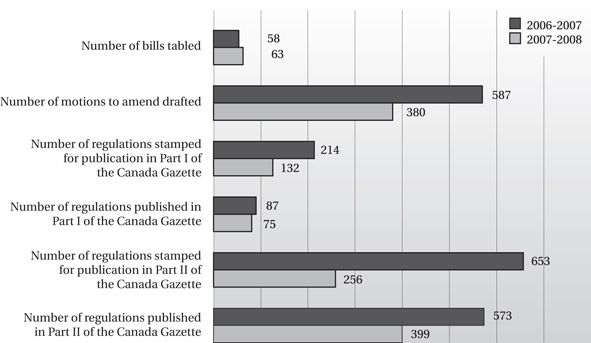
Legislative Services Inventory
The following factors are relevant to understanding year-to-year fluctuations in the legislative services inventory:
- While the number of regulations published in Part II of the Canada Gazette has decreased, the average size of these regulations increased, as evidenced by the slight increase in the number of pages published in the 2007–08 fiscal year (3,465) as compared to that published in the 2006–07 fiscal year (3,300). There is also an increasing complexity in some major regulatory files. By way of examples, the Ontario Fisheries Regulations, the Federal- Provincial Fiscal Arrangements Regulations, the Energy Efficiency Regulations, the Vessel Operation Restriction Regulations, the Cargo Fumigation and Tackle Regulations, and the Marine Personnel Regulations all represented very complex regulatory initiatives.
- With regard to the decline in the number of motions, a new session of Parliament and the reintroduction of bills from the previous session meant that there were no amendments in September and October and very few in December and January. In addition, in the two previous fiscal years, there were certain bills which required numerous motions (e.g., Federal Accountability Act, Public Servants Disclosure Protection Act, and First Nations Fiscal and Statistical Management Act); this was not the case in the 2007-08 fiscal year.
2. Managing our Resources Effectively to Meet Government of Canada Legal Needs
An important means for tracking the effective management of resources is through ongoing monitoring of workloads. In this vein, a large portion of the Department’s work is devoted to managing litigation files — thus for example, just over one-half (54 per cent) of the actively managed files in the departmental inventory for 2007–08 were litigation files while 40 per cent were advisory files and the remaining 6 per cent were legislative files (see Figure 2).
Figure 2 – Distribution of Legal Files by File Type and Level of Effort
| Distribution of Legal Files by File Type |
Distribution of Legal Files by Level of Effort |
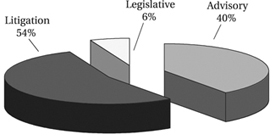 |
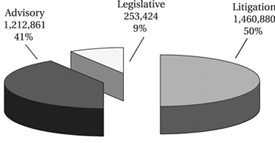 |
| Total number of active legal files worked on in 2007-08: 69,697 |
Total level of effort dedicated to providing legal services: 2,927,165 professional hours |
There is a high correlation between the volume of files and the levels of resources devoted to managing them as demonstrated by the fact that litigation files accounted for 50 per cent of the total level of effort devoted by legal counsel to substantive files, while advisory files accounted for 41 per cent and legislative files accounted for about 9 per cent.
As the government’s law firm, the Department of Justice finds that the demand for services is varied and covers a broad range of areas of practice. To meet demand, the Department delivers services through the portfolio structure across the country. Broken down by Portfolio, an overview of workloads reveals that a large portion (42% of file inventory) of the Department’s work is in support of the 21 client departments that comprise the Business and Regulatory Law (BRL) Portfolio (see Figure 3). About one-fifth of the file inventory is in the Citizenship, Immigration and Public Safety (CIPS) Portfolio and another 18 per cent is in the Tax Law Services Portfolio.
There are striking differences in the mix of advisory and litigation files across these three portfolios. For example, in the BRL Portfolio, the majority of files in the active inventory are advisory files whereas in both the CIPS and Tax Law Portfolios the majority of the files in the active inventory are litigation files.
Figure 3 – Distribution of Files and Level of Effort by Portfolio
| Distribution of Files by Portfolio |
Level of Effort Dedicated to Legal Files by Portfolio |
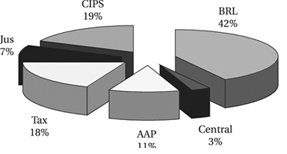 |
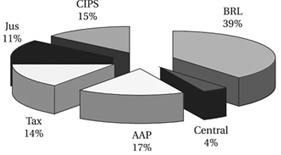 |
| Total number of active legal files worked on in 2007-08: 69,697 |
Total level of effort dedicated to providing legal services: 2,927,165 professional hours |
Although the levels of demand and the nature of the work vary across portfolios, in comparison to 2006–07 data, the distribution of files and the corresponding levels of effort devoted to the management of those files have remained relatively stable.
Figure 4 – Distribution of Files and Level of Effort by Region
| Distribution of Legal Files by Region | Level of Effort Dedicated to Legal Files by Region |
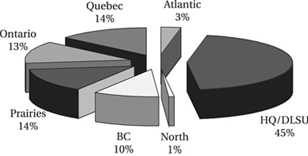 |
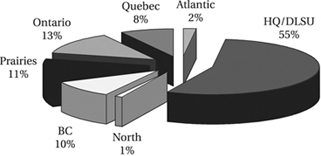 |
| Total number of legal files worked on in 2007-08: 69,697 |
Total level of effort dedicated to providing legal services: 2,927,165 professional hours |
| HQ/DLSU includes Legislative Services, Litigation Branch and Public Law Sector. |
HQ/DLSU includes Legislative Services, Litigation Branch and Public Law Sector. |
Figure 5, below, shows the distribution of the age of the litigation inventory at closing / resolution for 2007–08. During the year, there were 37,716 actively managed litigation files of which 14,974 files were closed or resolved.11 As can be seen, the majority of litigation files closed during the reporting period had been opened for six months or less, demonstrating the Department’s success at resolving a large proportion of litigation files in a relatively short period of time.
Figure 5 – Age of Litigation Files at Closing
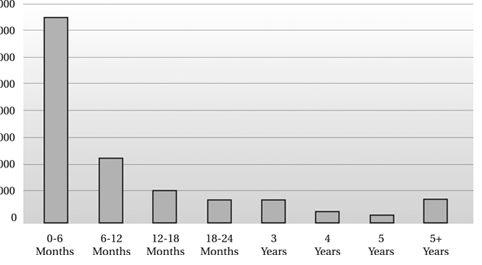
11 Of these 14,974 closed litigation files, 1,871 litigation files were initiated by the Crown, 10,843 litigation files were initiated against the Crown and 2,260 litigation files involved the Crown as a third party (intervener status).
Effective Management of Legal Risks
Another important element of effective management of resources concerns legal risk management. Legal risk management applies to all government activities where legal risk may arise, from policy development to program implementation and service delivery and, of course, to litigation. Consequently, the management of legal risks is a joint responsibility between client departments and the Department of Justice.
Legal risk management is a part of virtually all the legal and policy work that the department undertakes. Sometimes it is required during the early days of an issue to avoid litigation. Other times, it occurs when an issue or a case assumes a higher profile and senior officials or ministers need to be informed as to the nature of the legal risk involved.
Figure 6 – Distribution of Litigation Files and Level of Effort by Level of Risk
| Distribution of Litigation Files by Level of Risk | Level of Effort for Litigation Files by Level of Risk |
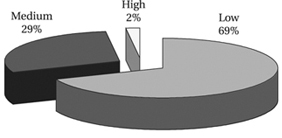 |
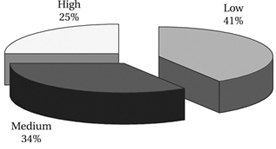 |
12 A number of litigation files do not have a risk level identified and are either labelled “unable to assess” or have “not yet been evaluated.” Figure excludes these files.
Figure 7 – Total Levels of Effort Devoted to Low, Medium and High-risk Litigation by Level of Counsel
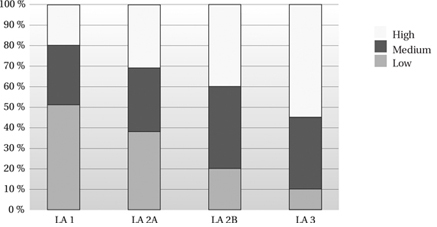
* Higher risk files consume proportionately more senior effort than lower risk files.
** “LA 1”, “LA 2A”, “LA 2B” and “LA 3” represent the internal classification levels for DoJ counsel.
As previously mentioned, the vast majority of litigation files are managed in the Regional Offices and the nature of the actively managed litigation inventory varies quite a bit across the six Regional Offices. In comparing the impacts of the differing levels of risk across the country, what is most striking is the impact on the levels of resources (see Figure 8).
By way of examples, the Prairies Regional Office expends roughly equivalent levels of effort managing high-risk and low-risk files even though the low-risk files represent 58 per cent and high risk represent
3 per cent of their actively managed litigation inventory.
Figure 8 – Total Levels of Effort Devoted to Low, Medium and High Risk Litigation by Regional Offices
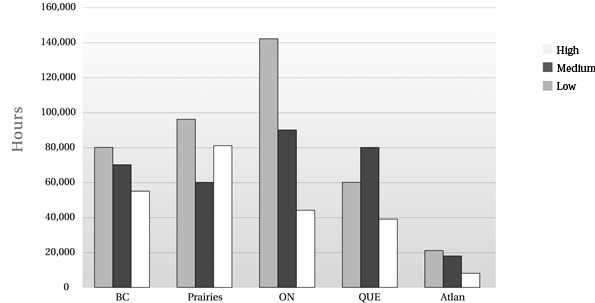
Another means by which the Department effectively manages resources is to apply dispute resolution mechanisms in order to resolve disputes between parties where possible and appropriate. This alternative to litigation was applied to 2,130 of the 12,714 actively managed litigation files initiated by the Crown or against the Crown that were closed or resolved during fiscal year 2007–08 (or 17 per cent of resolved litigation files). Most of these files (1,697 or 80 per cent) were settled by mediation, arbitration or negotiation.
Litigation Outcomes
Another important indicator that we monitor relative to the services we provide to government concerns litigation outcomes. We monitor this because one of our key roles is to represent the Crown’s interests before the Courts.
Figure 9 graphically portrays the distribution of litigation files resolved during 2007–08. As can be seen, approximately two-thirds of the files (64 per cent) were adjudicated, while just over one-quarter were settled prior to a final adjudicated result. About one in eleven files were closed administratively.
The overwhelming majority of the litigation files involve proceedings initiated against the Crown. Specifically, 82 per cent of the litigation files in our actively managed inventory involve claims against the Crown. Approximately 14 per cent of the inventory involve proceedings initiated by the Crown, and the remaining 4 per cent of files are ones in which the Crown is not directly implicated (e.g., intervener status).
Figure 9 – Litigation Outcomes
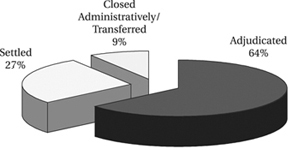
A quick review of the files resolved last year demonstrates that where the Crown initiated the proceedings, the Crown’s position was allowed or granted in 91 per cent of the files. Conversely, where proceedings were initiated against the Crown, the plaintiff’s position against the Crown was allowed or granted in only 30 per cent of the files. In the remaining 70 per cent of the files initiated against the Crown, the proceedings were dismissed, denied or disallowed. Figure 10 below graphically portrays this distribution.
Figure 10 – Outcome of adjudicated files for which proceedings were initiated by /against the Crown.
| Proceedings Initiated by the Crown | Proceedings Against the Crown |
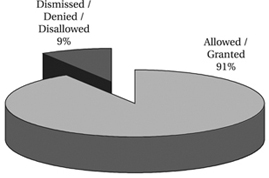 |
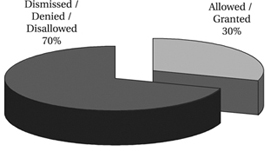 |
Figure 11 below summarizes the Crown results for all litigation files closed during the reporting period regardless of whether they were initiated by or against the Crown. As can be seen, the Crown’s position was upheld on all issues in over two-thirds (69 per cent) of the litigation files closed during the past fiscal year. In an additional 13 per cent of the files, the Crown’s position was partially upheld on some but not all of the issues central to the dispute. Conversely, the Crown’s position was not upheld in only 18 per cent of the files.
Figure 11 – Crown Results in Litigation Files
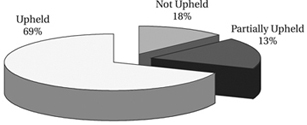
Highlights of Significant Litigation Files Resolved During 2007–08
During 2007–08, the Supreme Court of Canada (SCC) rendered 55 decisions. 13 Of these, the Government of Canada was involved in 31 cases either as an appellant, a respondent or an intervener. The following is by no means an exhaustive listing of the major files, but does provide highlights of some major litigation as a means to provide the reader with a sense of the range and types of issues and challenges for which the Department represents the Crown’s interests in front of the Supreme Court.
13 For a complete listing of Supreme Court of Canada outcomes, please consult the following website:
http://scc.lexum.umontreal.ca/en/
Victor Buffaloand Samson Band v. HMTQ
Two Bands (Samson and Ermineskin) commenced actions against the Crown in 1989 and 1992 respectively, alleging historical and ongoing mismanagement and breach of fiduciary duty in relation to monies held in the Consolidated Revenue Fund, oil and gas situated on their reserves and the funding of programs and services. The Bands are seeking damages, including interest, in excess of $10 billion. The claims against the Crown were dismissed at trial and the appeal to the Federal Court of Appeal was unsuccessful. The Bands obtained leave to appeal to the Supreme Court of Canada and their appeal was heard in May of 2008. The decision of the Supreme Court of Canada is under reserve.
Canada (Attorney General) v. JTI-Macdonald Corp.
In response to the 1995 decision of the Supreme Court of Canada in RJR-MacDonald Corp., Parliament enacted the Tobacco Act and related Regulations, which permitted certain types of advertising but restricted or eliminated others. The Regulations also increased the space occupied by mandatory health warnings from 33% to 50%. The tobacco companies challenged the new legislation on the basis of a violation of their freedom of expression. The Supreme Court dismissed the cross-appeal of the tobacco companies and allowed the appeal of the Attorney General. Although the Court found that most of the provisions at issue violated freedom of expression, she was also of the view that the limit on free expression could be justified in a free and democratic society.
Charkaoui v. Canada (MCI)
In its ruling, the Supreme Court of Canada generally affirmed the government’s ability to use immigration law to attempt to remove non-citizens considered a threat to national security, and to detain or impose strict conditions of release pending deportation. However, the Court found certain aspects of the in camera, ex parte hearing process unconstitutional. Subsequent to the Court’s decision, the Department has worked to amend government legislation to remedy the constitutional deficiencies identified by the Court. In this vein, the Department is implementing the Special Advocates Program in 2008–09.
In addition to the various litigation files in front of the Supreme Court, the department was involved in numerous files where the application for leave to appeal to the Supreme Court of Canada was dismissed, reinforcing the position defended by the Crown. Two note-worthy examples of such cases are presented below.
Authorson v. Canada
In July 2007, the Ontario Court of Appeal dismissed this class action brought on behalf of disabled veterans whose pensions and allowances had been administered by Veterans Affairs Canada. The court upheld Parliament’s decision to require the government to pay interest on these veterans’ accounts only from 1990 onward, and it overturned the order of the lower court which had awarded $4.6 billion in damages to the class. The class’ subsequent application for leave to appeal to the Supreme Court of Canada was dismissed in November 2007, ending this decade-long litigation file.
Thamotharem and Restrepo-Benitez v. Canada (MCI)
The Supreme Court of Canada dismissed applications for leave to appeal in two cases that challenged Immigration and Refugee Board guidelines and had the potential to require the re-determination of thousands of refugee claims. These cases also had the potential to negatively affect the ability of the Canada Border Service Agency to enforce valid removal orders.
The Department also represents the Crown’s interests in Federal Court, Tax Court and in other courts across Canada. The following seven examples provide brief descriptions to permit the reader to better understand some of the other significant litigation files with which the Department was involved during the past year.
Her Majesty the Queen v. Canadian Council for Refugees
In Her Majesty the Queen v. Canadian Council for Refugees, 2008 FCA 171, CIPS counsel persuaded the Federal Court of Appeal (the “FCA”) to overturn a Federal Court decision which had struck down the Safe Third Country Agreement (the “STCA”) between Canada and the United States. The STCA is a bilateral treaty which requires refugee claimants to seek protection in whichever of the two signatory countries they enter first, subject to certain exceptions. The Federal Court’s decision had created the potential for a significant and immediate increase in refugee claimants coming to Canada from the United States. In overturning the Federal Court’s decision, the FCA held that the STCA was not ultra vires the powers of the Governor in Council and that the Federal Court ought not have decided the Charter issues without a sufficient factual basis for doing so. The FCA decision means that officials at Canada’s borders may continue to rely on the STCA as way to help achieve the objectives of enhancing the orderly handling of refugee claims, strengthening public confidence in the refugee system and ensuring shared responsibility for protecting those in need.
GlaxoSmithKline v. Her Majesty the Queen
In this important transfer pricing case the Tax Court of Canada upheld CRA’s powers under the Income Tax Act to identify, determine and adjust such transfers of input costs to that which it considers fair market value in order to ensure that transfer pricing schemes cannot be used to avoid taxation in Canada.
Indian Residential Schools
Class Action Settlement Agreements were approved by the courts in nine Canadian jurisdictions and implementation proceeded after the opt-out deadline expired in August 2007. The court-sanctioned settlement agreement consists of four parts: common experience payment to be paid to eligible former students, independent assessment process for claims of sexual or serious physical abuse, healing and commemoration program and a Truth and Reconciliation Commission. This represents the largest class-action settlement in Canadian history. In British Columbia and the Yukon alone, approximately 11,500 former students have received common experience payments. In addition, the settlement agreements have resulted in 1,287 dispute resolution awards, 372 litigation settlements and 1,659 total settlements of former student abuse claims.
Davis et al. v. Attorney General of Canada
The Newfoundland and Labrador Court of Appeal denied certification of a class-action suit on behalf of more than 7,000 individuals of Mi’kmaq Indian ancestry, which sought $5.2 billion in damages related to a denial of status as “Indians” under the Indian Act, a consequent loss of entitlement to various statutory benefits and to have land reserves set aside for them.
Dumont/Manitoba M�tis Federation v. Canada
In December 2007, the Manitoba Court of Queen’s Bench dismissed a claim by the Manitoba M�tis Federation that the Crown had not fulfilled its duties under the Manitoba Act. The litigation raised significant financial risks. The Federation brought the matter to the Manitoba Court of Appeal.
Roger William
In November 2007 the BC Supreme Court dismissed an extensive claim for Aboriginal title by the Tsilhqot’in First Nation, but issued a non-binding opinion that Tsilhqot’in Aboriginal title over a much smaller area exists. This file is important in that the scope and content of Aboriginal title and the applicable legislative regime are important issues for all Canadians, because they help to define Canada’s ongoing relationship with Aboriginal peoples and the role of the provinces.
Lax Kw’alaams Indian Band v. Canada and British Columbia
In April 2008, the BC Supreme Court dismissed the Lax Kw’alaams claim of an Aboriginal right to harvest and sell fish on a commercial scale. The claim, which has been appealed to the BC Court of Appeal, challenges the scope of federal regulation of the fishery as a public resource and thus the ability of the Minister of Fisheries and Oceans to manage the Pacific commercial fishery.
3. Supporting Other Government Departments with High-quality Legal Services
As part of the Department’s efforts to ensure the provision of high-quality legal services across government, the Department continued to roll out the first cycle of its standardized client feedback survey to gauge perceptions of legal advisory, litigation and legislative services. The Department developed the survey questionnaire in consultation with Statistics Canada and has partnered with Statistics Canada, Canada Public Service Agency and Public Works and Government Services Canada to roll out the web-based survey to a representative sampling of clients from across the federal government.
As of March 31, 2008, we had received feedback from 4,150 Government of Canada employees at the EX minus one and equivalent levels through to the Deputy Minister level from across 27 departments and agencies. Our overall response rate has been 31 per cent, which is within acceptable standards for a web-based survey of this type.
Survey respondents were asked to provide feedback on a ten-point Likert scale on three core elements of service quality — responsiveness, usefulness and timeliness — of our legal advisory, legislative and litigation services, as well as on dispute resolution services where appropriate. As we had no prior benchmarks, the Department has set an arbitrary target of 8.0 on the 10-point scale.
Based on the results to date, respondents have provided very positive feedback on the quality
of the legal services. The Department has met or exceeded the targets with the exception of timeliness of advisory services (see Figure 12).
Figure 12 – Feedback Survey Results
|
Advisory Services |
Litigation Services |
Legislation Services |
Dispute Resolution Services |
|
| Overall Satisfaction | 8.1 | 8.4 | 8.2 | 8.4 |
| Responsiveness | 8.6 | 8.4 | 8.5 | 8.6 |
| Usefulness | 8.1 | 8.2 | 8.0 | 8.2 |
| Timeliness | 7.8 | 8.3 | 8.0 | 8.3 |
